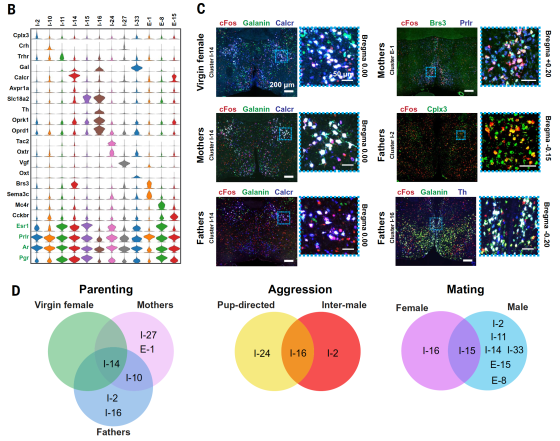Knowing when and how to respond appropriately to social situations is an intractable problem to an infant which incredibly becomes more and more solvable as we age. By adulthood, we respond to social scenarios fluidly, interpreting contextual signals in others that can be eminently subtle. We are able to read others’ grief and comfort them with a hug or kind words; we (usually) suppress engaging in socially unacceptable behavior like spontaneously breaking out in song during a lecture. Amazingly, our social brain orchestrates it all. It is a dynamic apparatus, composed of learned behaviors and inherited responses, malleable through our own experiences, and those of our parents. This system is what fascinates Dr. Catherine Dulac, the Higgins Professor in Molecular and Cellular Biology at Harvard University. Her lab is focused on the mechanisms at work on the molecular, cellular and systems level in the social brain of the mouse.
Of particular interest to Dr. Dulac is how the brain uses external sensory information to effect social behavioral responses, the underlying circuitry mediating sex-specific behavior and social representation, as well as the genomic basis of imprinting. Crucial to these lines of inquiry is the establishment of neuronal classification and molecular identity in brain areas controlling social behavior. To this end Dr. Dulac’s lab has recently engaged in a collaborative effort (found here) with the lab of Harvard Biophysicist Dr. Xiaowei Zhuang to apply single-cell RNA sequencing (scRNA-seq) as well as a recently-invented (by the Zhuang lab) screening platform called MERFISH (Multiplexed Error-Robust Fluorescence In-Situ Hybridization) to the hypothalamic preoptic area, a region critical for regulation of social behaviors such as mating and parenting as well as homeostatic functions such as thirst and sleep. Both scRNA-seq and MERFISH allowed for quantification in single cells of the expression pattern of genes in the profiled region; where scRNA-seq allowed for more genes to be quantified in expression pattern, MERFISH allowed each individual cell’s gene expression (limited to 155 genes) to be profiled across the entire region in its native context, preserving critical brain spatial architecture.

By additionally performing MERFISH on animals that engaged in different types of social behaviors (parenting, aggression, mating), the authors were able to first identify the neuronal populations involved in these behaviors with c-Fos, a gene marker of recent neuronal activity, and subsequently characterize the expression pattern of their other 154 probed genes. This allowed for a detailed transcriptional profile of these neurons, yielding key marker genes for each identified population. Crucially, this experiment also highlighted the overlapping role of some neuronal populations in multiple types of behaviors. For example, neurons identified with the marker gene Cplx3 (C) (MERFISH cluster I-2) appeared to be active in father mice engaging in parenting behavior, virgin male mice engaging in inter-male aggression, as well as male mice engaged in mating behavior (D). Additionally, there were multiple neuronal populations selectively active during a given behavior, such as neurons identified with the marker genes Brs3 and Prlr (C) (MERFISH cluster E-1), which were only active in mother mice engaging in parenting behavior (D).
This experiment shows the fundamental value of using multiplexed genomic assays to identify the neural substrates of social behavior. By identifying these critical neuronal populations with marker genes and unveiling their key expressed genes it may be much easier in the future to experimentally target, record endogenous activity from these populations as well as functionally manipulate these neurons in vivo.
To learn more about Dr. Dulac’s research, please join us for her talk titled, “Molecular, cellular, and circuit levels control of social behaviors” on Tuesday, January 21st at 4:00 P.M. in the Marilyn G. Farquhar Seminar Room at the Center for Neural Circuits and Behavior.
Written by Oren Wilcox, a 1st year PhD student in the Neurosciences Graduate Program, currently rotating in Eiman Azim’s laboratory at the Salk Institute.